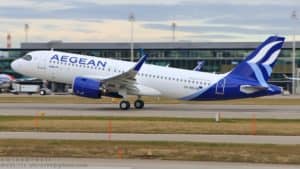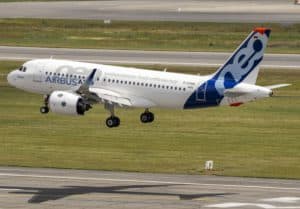Airbus offers two different aircraft models in their A320 series: the Airbus A-320 and Airbus A-319. Both of these planes are very popular with airlines all over the world, but they have some key differences that set them apart.
In this article, we will compare the features of the Airbus A-320 with those of the Airbus A-319 to help you decide which one is right for your needs.
| Aircraft: | Airbus A320neo | Airbus A319neo |
|---|---|---|
| Photo: |
 |
 |
| Country: | France | France |
| Manufactured: | from: 2014 to: Present | from: 2012 to: Present |
| ICAO: | A20N | A19N |
| Price: | $110 million | $101.5 million |
| Avionics: | - | - |
| Engine: | 2x Pratt & Whitney PurePower PW1100G-JM / CFM International’s LEAP-1A | 2x CFM International LEAP-1A or Pratt & Whitney PW1100G[155] |
| Engine Type: | Turbofan | Turbofan |
| Power: | 27,120 pound-force | 24,100 pound-force |
| Max Cruise Speed: |
473 knots 876 Km/h |
450 knots 833 Km/h |
| Approach Speed (Vref): | - | 126 knots |
| Travel Range: |
3,400 Nautical Miles
6,297 Kilometers |
3,700 Nautical Miles
6,852 Kilometers |
| Fuel Economy: | - | - |
| Service Ceiling: | 39,800 feet | 39,800 feet |
| Rate of Climb: | - |
3500 feet / minute 17.78metre / second |
| Take Off Distance: |
1951 metre 6,400.84 feet |
2164 metre 7,099.65 feet |
| Landing Distance: | - |
677 metre 2,221.10 feet |
| Max Take Off Weight: |
79,015 Kg 174,196 lbs |
75,478 Kg 166,399 lbs |
| Max Landing Weight: |
67,400 Kg 148,590 lbs |
63,900 Kg 140,874 lbs |
| Max Payload: |
20,000 Kg 44,092 lbs |
17,690 Kg 39,000 lbs |
| Fuel Tank Capacity: |
7,060 gallon 26,725 litre |
7,060 gallon 26,725 litre |
| Baggage Volume: |
37 m3 1,307 ft3 |
- |
| Seats - Economy: | 194 seats | 160 seats |
| Seats - Business Class: | - | - |
| Seats - First Class: | - | - |
| Cabin Height: | - |
11.76 metre 38.58 feet |
| Cabin Width: |
3.7 metre 12.14 feet |
3.70 metre 12.14 feet |
| Cabin Length: |
27.51 metre 90.25 feet |
23.78 metre 78.02 feet |
| Exterior Length: |
37.57 metre 123.26 feet |
33.84 metre 111.02 feet |
| Tail Height: | 11.76 metre - 38.58 feet | 12.11 metre - 39.73 feet |
| Fuselage Diameter: |
3.95 metre 12.96 feet |
3.95 metre 12.96 feet |
| Wing Span / Rotor Diameter: |
35.80 metre 117.45 feet |
35.8 metre 117.45 feet |
| Wing Tips: | No Winglets | Other |
| More Info: | Airbus A320neo | Airbus A319neo |
|
Data presented is for entertainment purposes and should not be used operationally.
|
Other Airbus A320neo comparisons:
Other Airbus A319neo comparisons:
Airbus A320
The Airbus A-320 is a narrow-body jet airliner with a capacity of 150 passengers. It is the first aircraft in the Airbus A-320 family and was introduced in 1988. The A-320 has a range of 3,700 nautical miles and is powered by two CFM56 turbofan engines.
The A-320 is one of the most popular aircraft in service, with over 6,000 delivered as of 2016. It is used by a variety of airlines around the world and has been operated by over 400 carriers.
Why was the Airbus A320 developed?
The A-320 was developed by the European aviation consortium Airbus Industrie, which was formed in 1970. The company’s goal was to break the American duopoly on the global aviation market.
To do this, they knew they had to develop an aircraft that could compete with the Boeing 737, which was the best-selling jetliner at the time. The A-320 was designed to be more fuel-efficient than the 737, and it quickly became a success with airlines around the world.
Today, the A-320 is still one of the most popular jetliners on the market, with over 8,000 units delivered.
What purpose does the Airbus A320 serve?
The Airbus A-320 is a wide-body aircraft manufactured by Airbus. It is the world’s largest passenger airliner and has a range of over 8,000 miles. The A-320 is used by many airlines around the world, including British Airways, Virgin Atlantic, and Lufthansa.
In the European aviation industry, the A-320 is used extensively for both short-haul and long-haul flights. For short-haul flights, the A-320 provides a comfortable and efficient alternative to trains and buses.
For long-haul flights, the A-320 offers passengers a wide variety of amenities, including in-flight entertainment and an extensive food and beverage menu.
With its large passenger capacity and long range, the Airbus A-320 is an essential part of the European aviation industry.
Airbus A-319
The Airbus A-319 is a single-aisle aircraft with a capacity of 140–160 passengers. It has a range of 3,700 nautical miles and can fly at a cruising speed of 567 mph.
The A-319 is powered by two CFM International CFM56 engines, each of which produces 33,000 pounds of thrust. The aircraft’s fuselage is made of aluminum alloy, and its wings are equipped with winglets to reduce drag.
The plane also features an advanced avionics system, which includes a head-up display and an enhanced flight control system.
As a result of these features, the A-319 is one of the most efficient and comfortable aircraft in its class.
Why was the Airbus A319 developed?
The Airbus A-319 is a popular model of commercial airplane developed by the European aviation industry. It is a derivative of the successful A320 model and was launched in 1997.
One of the key reasons for its development was to provide an airplane with better range and performance than the existing A320 model, while still being able to use the existing infrastructure and airports.
In addition, the A-319 was designed to be more fuel efficient than its predecessor, which was important at a time when oil prices were on the rise. The A-319 has been a success for Airbus and has become one of the most popular models in their fleet.
It’s widely used by airlines all over the world and has become known for its reliability and comfortable passenger experience.
What purpose does the Airbus A319 serve?
The Airbus A-319 is a popular commercial airliner that is used by many airlines around the world. It is a member of the Airbus A320 family, which also includes the A318, A320, and A321.
The A-319 is typically used on short-haul routes, while the other members of the family are used on longer routes. The A-319 has a capacity of up to 156 passengers, and it is powered by two engines. It has a range of up to 3,700 kilometers, and it can reach a speed of up to 890 kilometers per hour.
The A-319 is one of the most popular aircraft in the Airbus fleet, and it is an important part of many airline operations.
Differences In The Airbus A320 & The Airbus A319
The Airbus A-320 is a popular family of twin-engine, single-aisle commercial jetliners. First introduced in 1987, the A-320 has become one of the most widely used aircraft in the world. The A-320 is available in a variety of different models, each with its unique capabilities. The A-319 is one of the smaller members of the A-320 family. It shares many of the same features as its larger sibling, but it has a shorter range and can seat fewer passengers. Here are some of the other key differences between the A-320 and A-319:
The A-320 has a maximum range of 6,700 kilometers, while the A-319’s range is limited to 5,950 kilometers.
The A-320 can seat up to 180 passengers in a two-class configuration, while the A-319 can accommodate only 144 passengers in the same cabin layout.
The A-320 is powered by two CFM International CFM56 engines, while the A-319 uses a slightly less powerful variant of this engine, the CFM56-5B3/P.
The A-320 has a wingspan of 35 meters, while the A-319’s wingspan is slightly shorter at 33 meters.
The length of the A-320 is 37 meters, while the A-319 is about 4 meters shorter at 33 meters.
Similarities In The Airbus A320 & The Airbus A319
The A-320 and A319 models of commercial passenger jet aircraft are both produced by a European manufacturer, Airbus. The A-320 made its maiden flight in 1987 while the A-319 followed in 1996.
The similarities between these two models of aircraft are significant. Both the A-320 and A-319 have a cruising speed of around 561 mph, a service ceiling of 39,000 ft, and a maximum take-off weight (MTOW) of around 160,000 lb. In terms of engines, they can both be powered by CFM56 or IAE V2500s.
In terms of range, the A-320 can fly up to 3,700 nautical miles while the A-319’s range is shorter at 3,100 nautical miles. Thus, we see that while there are some differences between these two models of aircraft, there are also many similarities.
Airbus A320: The Better
The Airbus A-319 is a popular choice for short-haul flights, but the Airbus A-320 offers some advantages that make it a better choice for longer routes. The A-320 has a longer range than the A-319, thanks to its more efficient engines.
It also has a larger cabin, which provides more space for passengers and luggage. The A-320 is also equipped with Winglets, which help to improve fuel efficiency by reducing drag.
As a result, the A-320 can fly further and use less fuel than the A-319, making it a more cost-effective choice for airlines. In addition, the A-320 is available in a variety of configurations, including a stretched version that can seat up to 180 passengers.
The Airbus A-320 is a versatile and efficient plane that is well-suited for long-haul flights.
Airbus A319: The Better
The Airbus A-319 is a narrow-body plane that was designed for shorter routes with lower passenger capacity. The A-320, on the other hand, is a wide-body plane that is better suited for long-haul flights. While both planes are similar in many ways, there are a few key factors that make the A-319 a better choice for certain types of flights.
For one, the A-319 has a shorter wingspan than the A-320, which makes it more agile and maneuverable. This is especially beneficial on shorter flights where there is less time to make corrections.
In addition, the A-319 has a higher cruising speed than the A-320, which means it can cover more ground in less time. Finally, the A-319 uses less fuel than the A-320, making it more environmentally friendly and cost-effective.
Conclusion
When choosing between Airbus A-320 and Airbus A-319 aircraft, the decision will ultimately come down to the requirements of the flight. The Airbus A-320 offers a longer range and the ability to transport more passengers over long distances.
It is also available in a variety of configurations, including a stretched version that increases capacity even further.


